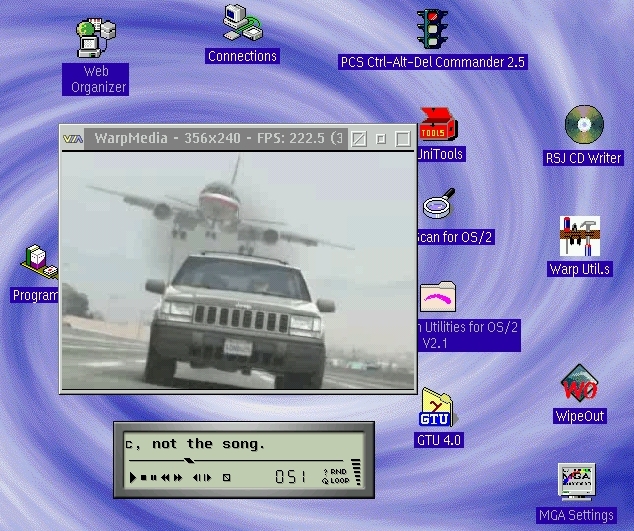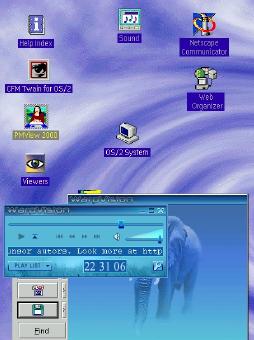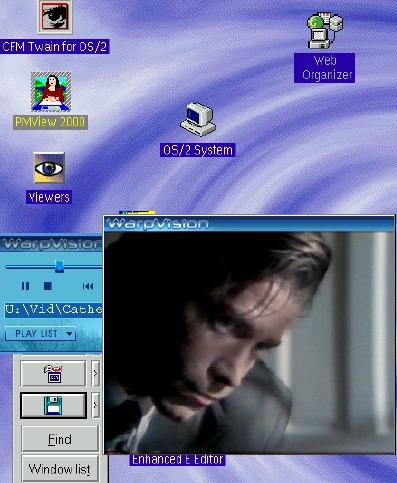|
August 2002
Multimedia Roundup: Video Players for OS/2Multimedia could well be the most conspicuous area in which OS/2 has always lagged behind. It was never a top priority, and back when the commercial developers jumped ship, the situation pretty much figured to remain that way. After all, the core strengths of OS/2 were geared towards extreme reliability in a serious business environment, support for legacy applications, and -- once properly set up -- keeping out of the user's way. Multimedia programs, however enjoyable they may be, in most cases decidedly belong to the sizzle rather than to the steak. Frills and sizzle are really the stock-in-trade of a certain other well known operating system. (Obviously, if you make your living with PhotoShop, or editing sound or video, the preceding comments do not apply to you.) If we were apt to develop a complex over the status of our favored OS, multimedia would be a good place to start. Probably nowhere else as keenly are we made to feel like surviving members of the Flat Earth Society, or the fellow in that old Stones song who was "still perfecting ways of making sealing wax." But that hasn't prevented some determined, volunteer developers from trying. If and when they succeed, there is a certain against-all-odds, root for the underdog feeling at the way they have pressed on despite minimal resources. You have to tip your hat and acknowledge a really neat hack. Multimedia encompasses enough ground that distinctions must be drawn. In the image viewing and manipulation category, we still have an excellent program in PMVIEW, whereas other, more heavy duty image editing programs like EMBELLISH, TrueSpectra PhotoGraphics, and Color Works reached the end of their development, with the first two of the latter three being released to the community as freeware. (I will leave the camera-related utilities to Tony's INK column.) For playing music, which today usually means MP3 files, OS/2 has actually been in rather good shape: WARPAMP never made it past beta, but remains reasonably functional, PM123 is still around, and there are apparently others I'm not aware of. The real standout, in my opinion, is the great Z! player -- freeware available from http://dink.org/z/. Still, in the multimedia metaverse, the marquee players belong to video. The closest thing to a video editing package for OS/2 that I'm aware of was Main Actor, from a German company, which was discontinued on this platform. To the extent I can recall a brief demo seen a couple years ago, it was oriented more towards animation or presentations made up of still images. There was also a program called Video In (for video capture) from the old Warp Bonus Pack, with which I am not familiar, other than having noted complaints at the time regarding the difficulty of scrounging up supported hardware for it. Reaching back a ways, we've had PMMPEG, developed by Vitali Pelenyov. This Presentation Manager shareware player for MPEG-1 video streams stopped at version 3.32 in the early part of 1998, although BMT Micro will still sell you a license for it. The feature set was pretty basic, convenience features rather sparse. It could make use of either its own engine, which played video clips without sound, or the OpenMPEG engine that was included with the Netscape PluginPak for OS/2, which would usually also render the sound portion of MPEG-1 clips, but offered a relatively mediocre visual quality in the video. Naturally, this player could not handle other video codecs and later MPEG implementations, but it would simply refuse to play them. In various trials with unplayable clips, I might see a black or green screen for the PMMPEG window, or one with a rapid static interference pattern, but no lockups or crashes. The curious thing is that this over-four-years-old PMMPEG player, using one of its engine choices or the other, can still play many contemporary video clips that stop the more recent OS/2 freeware players dead in their tracks. Go figure. Our latter day video player choices come down to two OS/2 contenders, and one dark horse that runs in DOS! The first of the OS/2 development projects is Warpmedia. This is from a group in Sweden, the Software Developers Guild, previously responsible for WarpAmp, the MP3 player roughly patterned after WinAmp. Going back to the earliest WarpAmp beta, SDG seems to have a disconcerting history of coming out with some intriguing software release, then disappearing altogether for long periods of time. Years, even. Then they resurface unexpectedly, with another one. As we go to press, their website at http://www.sdg.os2.nu is down (again), and they never responded to emails intended to elicit some better information for this article. It's too bad, because I can't tell you if this project is still breathing or not, and because this very promising player with the tiny, minimalist interface is as slick as any of them in the results it gives you, on those video clips that it will play. Generally speaking, the many videos it won't play are the ones Warpvision won't play either -- the main difference being that when Warpmedia chokes and dies it does so much more gracefully, after which it is easier to get the carcass off your desktop.
Over time, I had been using successive releases of the "Warpmedia Technology Preview." I would keep trying with certain test videos, such as the comedic short film "405 - The Movie," released in the DIVX format by a couple of aspiring filmmakers who created their film's special effects inside a Macintosh. The film got great play via the internet and talk shows, garnering the duo some real opportunities in Hollywood. At the time this film first came out, you needed a dedicated DIVX player even to run it under Windows. Warpmedia at some point added support for DIVX, though you had to pick up the codec separately, from a URL listed in the package's documentation. For a considerable period, Warpmedia releases would play "405," but in a ridiculously hyper blink-of-an-eye speed, without any sound. It still plays without sound, and far too quickly, but not as much so as previously. Other improvements gradually occurred with some hitherto troublesome MPEGs and AVIs, for which I regret not keeping better notes along the way. The 1x08 drop (November '01) is the one to get, if you intend to try this out. Unfortunately, Hobbes does not seem to have this last release of WM to date, which may be hard to find. Meanwhile, Warpvision has been forging ahead on its own impressive development track. A group in Kiev is behind this one, and lately they seem to have a new drop of some major WV components every couple weeks. Much earlier in its history, WV required ODIN in order to run, but thankfully this requirement was dispensed with. For a good while after that, I still could not get WV to do anything. No less an authority than SCOUG's own multimedia guru Jerry Rash told me his experience was much the same, and if Jerry can't get something to work, that is a very bad sign indeed. But this all changed some time last year, and the WV team has been making serious strides ever since. It has been gratifying to watch their gradual progress, as sound started to appear in the video clips WV played. "405 -- The Movie" now plays at close to its proper running time, though still without sound. The sound that is heard in other video files is still prone to some frame synchronization issues, but this is also better than before.
WV now supports the .ASF format, which has gained popularity in the Windows world and otherwise would have required Windows Media Player. Recent changelogs mention the beginnings of DVD support. Lacking a DVD drive, I haven't tested this myself, and, according to the WV documentation, you should pay close attention to the UDF driver version before trying this. The latest news and component releases from WV can be picked up at http://os2.kiev.ua/en/wv.php. These players provide the set of controls you would expect to find: Play, Stop, Fast Forward, Rewind, Volume Control. WM was optimized for use with Scitech Display Doctor video drivers, and offered a widget for XWorkplace. Both WM and WV have playlists (which retain the name and location of the last video file played), are skinnable, run from the desktop once invoked, have a range of optional hot-key controls and command line parameters, and offer both windowed and fullscreen play modes. (But never switch out from a Warpvision fullscreen, without first reverting to its windowed display, or your next stop will be the computer's Reset switch ! This is probably not the best idea with the other players either, but I never tried it again, after that first mistake.) Strictly in terms of video display quality, my impression is that both Warpmedia & Warpvision hold their own, in comparison to the video playing I have seen on the Win platform. Feature functionality, range of codecs supported, and reliability would tell a different story, but that is hardly surprising, given the time and resources put into those players. The biggest problem I have found is that about half of the video files I have attempted to play -- a large number of them, drawn from a very large sampling -- administer a knockout punch to either WM or WV, requiring their current sessions to be terminated. This also is not terribly surprising, as there must be a large number of funky codec variants in circulation, each setting its own jumbo banana peel in the path of the video player programmers. Most likely, everyone reading this has come across some .MP3 music files, encoded with Windows-based encoders, that play poorly or not at all on non-Windows players. (Some of these files may have been badly encoded, regardless.) No doubt the Win-players are either more tolerant of the discrepancies, or better prepared to deal with them. The dark horse alluded to earlier is QuickView PRO for DOS, not to be confused with a similarly named multi-file-format viewer of some years back. I won't go into much detail about this product, because it is extensively discussed in a fine OS/2 eZine article from April 16 of this year. Suffice it to say I was amazed that a DOS-based player can do what it does. An OS/2 DOS session is quite DOS enough to run it. The range of supported codecs is much wider than what's available from WM or WV. I found the QV video stream to be somewhat grainier and less detailed than with the other players -- especially at fullscreen dimensions -- which may be due to the relative merits of my DOS session video drivers. Since QV requires Soundblaster compatibility from a sound card, and the one I'm presently using does not offer this, I could not guage QV's sound reproduction for the videos. Another problem (which may have other workarounds) was that certain files would not show up at all in the DOS session, because of long filenames or the common .MPEG file extension. Nevertheless, this product is definitely worth a looksee. QV Pro is perched on the fence, somewhere between shareware and commercial product, its author commenting that shareware is now widely discredited as a viable business model . . . but you can still try out a demo version. See the OS/2 eZine article for more information. Regarding all the above, you may well wonder: Why bother? ODIN is already here, and has been able to run several versions of RealPlayer. The VPC emulator recently debuted, and should be able to run any Win-32 items out there. Well, quite a few users have not found ODIN especially easy to set up, and VPC seems sure to set you back a tidy sum. Come to think of it, there's no telling whether use of VPC may open the door to harmful, unwelcome "hitchhikers" and stowaways from the Win-32 world. If a polished, truly capable and reliable native player turns up, it will be a very welcome development for OS/2, a belated milestone in which we can take a certain pride. Want to read about other discoveries by The Fox? The author welcomes your suggestions for future discoveries. Email the cunning fellow at TheFox@scoug.com.
P.O. Box 26904 Santa Ana, CA 92799-6904, USA Copyright 2002 the Southern California OS/2 User Group. ALL RIGHTS RESERVED. SCOUG, Warp Expo West, and Warpfest are trademarks of the Southern California OS/2 User Group. OS/2, Workplace Shell, and IBM are registered trademarks of International Business Machines Corporation. All other trademarks remain the property of their respective owners. |












